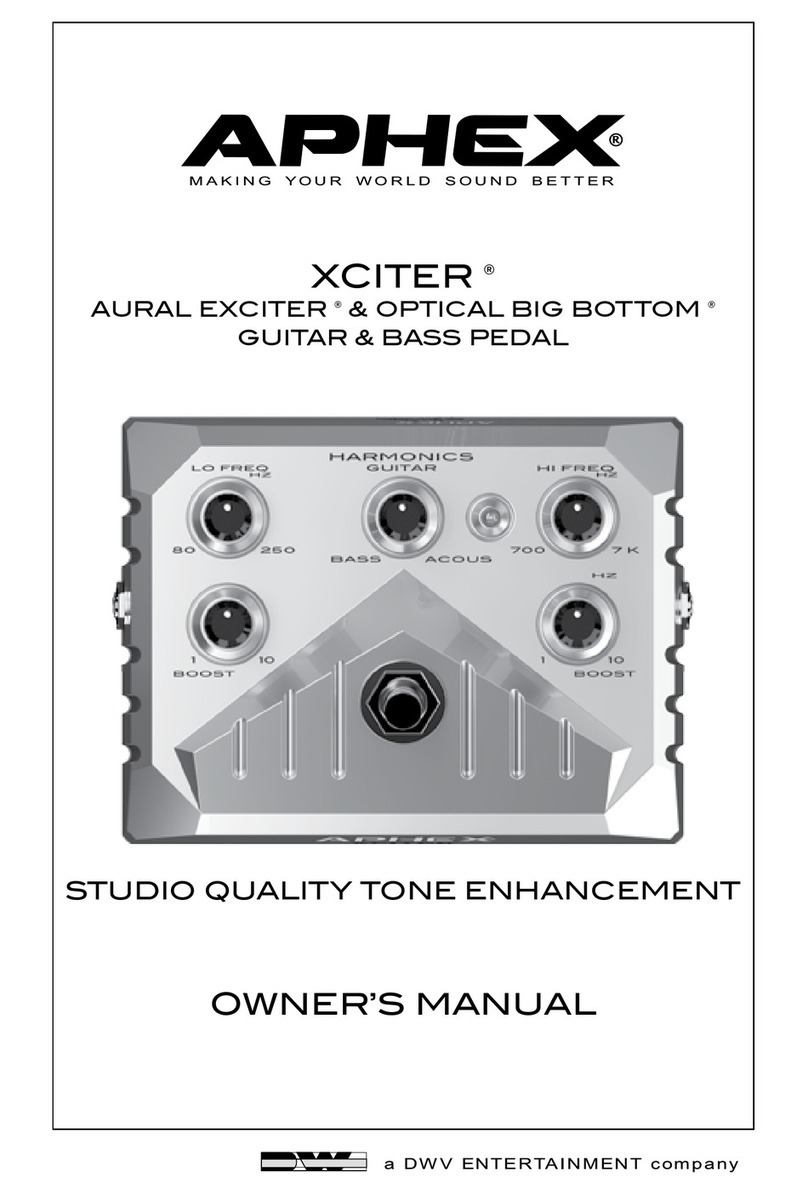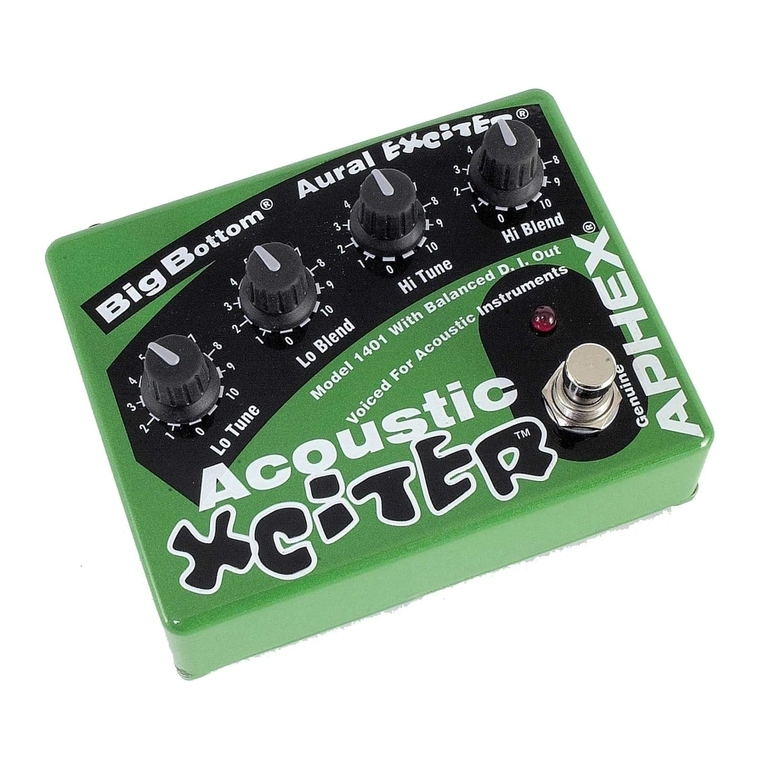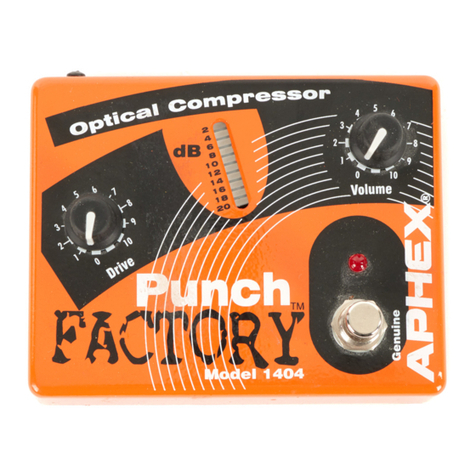Aphex 1401 Acoustic Xciter User manual

I n s t r u c t i o n M a n u a l
Models 1401 - 1402 - 1403
Genuine


1401 Acoustic Xciter™
1402 Bass Xciter™
1403 Guitar Xciter™
1. Hook-up ............................
2. Controls ............................
3. Tune-Up.............................
4. Theory................................
5. Specifications....................
6. Limited Warranty...............
7. Service Information...........
4
8
11
14
21
22
23
Contents
Copyright 2002 Aphex Systems Ltd.
All Rights Reserved.
All models have similar controls and features. The
range of adjustments and the internal parameters
are individually optimized for the different classes of
musical instruments.
I n s t r u c t i o n M a n u a l
Aphex P/N xxx-xxxx
Models Covered:

Models 1401 through 1403
Page 4
a. Direct By-Pass
When the unit is switched “off” (no effect) your instru-
ment is routed directly to the output jack and does
not pass through any electronics.
b. Input
When plugging in, make sure you set the input
active/passive switch to match your instrument’s
pickup. This assures the optimum level and imped-
ance match. The power is automatically switched
Power
Instrument
Input
Active (In)
Passive (Out)
Instrument
Output
Ground
Grounded(In)
Lifted (Out)
D.I. Balanced
150Ω Output
Mic Level
Wet(In)
Dry(Out)
Hot
1
3
2
1. Hook-Up

Instruction Manual
Page 5
on or off by inserting or removing the plug from
the input jack. Simply removing the plug from
your instrument does not turn off the Aphex unit.
c. Instrument Output
Connect this output to your amp’s input jack using
a good quality guitar cord. Use the same jack and
active/passive settings on your amplifier as you
would use if plugging the instrument directly into the
amp. That way, you’ll get normal volume and tone
when you switch the effect off, and your instrument
passes directly through the box to your amp’s input.
d. D.I. Output
Yes, your Xciter™ comes with a super quality bal-
anced D.I. output! Pin 2 of the XLR is hot while pin 3
carries a balancing impedance to set up a true bal-
anced line. Pin 1 is grounded through the ground-
lift switch. The D.I. output can be connected to the
microphone input of any preamp or sound mixer and
runs a level of typically -50 to -60 dBu depending
on your instrument’s volume setting. You can switch
the D.I. output to either wet (with effect) or dry (with-
out effect) buffered balanced output. The D.I. output

Models 1401 through 1403
Page 6
should normally be grounded. Don’t lift the ground
unless it actually eliminates hum or buzz.
e. External Power
When external power is used, the internal battery
becomes disconnected and will not experience a
power drain. A wide range of both a.c. and d.c.
supply voltages is acceptable for power (see speci-
fications) and it does not matter whether the center
pin is positive or negative. Almost any existing foot
pedal or stomp box power unit will work as long as
the plug fits the jack. The power jack fits a standard
6MM x 2MM power plug as used by most popular
stomp boxes. The Aphex Model 9 power adapter
is specifically designed for Model 1401, 1402, and
1403 Xciters.
f. 9V Battery
You can use any type of 9V battery that fits the snap
connector. You can use rechargables, but the Aphex
unit does not supply a charging circuit. You must
remove the discharged battery to recharge it with
an external charger. We recommend using long life
alkalines. The internal battery is replaced by remov-

Instruction Manual
Page 7
Battery Location
ing 4 screws holding the bottom cover. You can
expect from 100 to 150 hours of continuous use from
a fresh alkaline battery. Useful life is ended when the
battery voltage drops below 5.5 volts.
To extend battery life, always unplug the input
when the unit is not in use.

Models 1401 through 1403
Page 8
a. Big Bottom® - What It Does
For bass instruments, it dynamically enhances the
low end by deepening and expanding the bass tones
according to an adaptive process. It’s not just boost.
The effect protects speakers while it extends their
bass producing capability. For acoustic instruments
it “brings out the box“. In other words, it adds a
2. Controls

Instruction Manual
Page 9
warmer tone that makes the instrument sound bigger
and fuller. For guitars, it gives you another dimension
of expression at the lower end of the scale. It’s not
a synthesizer of any kind. It takes what is there and
enhances it intelligently.
Lo Tune
Sets the upper frequency limit for bass enhance-
ment. Enhancement occurs for all frequencies below
this point. The operating range of this control is opti-
mized for your Xciter model.
Lo Blend
Mixes in the amount of Big Bottom effect you want
from zero to the maximum available.
b. Aural Exciter® - What It Does
This is the real and original Aural Exciter especially
optimized for musical instruments. It can variously
be described as adding “air”, “bite”, “definition” or
clarity to the sound by smartly creating and manip-
ulating the harmonics of sound waves. As you will
experience, no other “Exciter” has the musicality of
the true Aphex Aural Exciter.

Models 1401 through 1403
Page 10
Hi Tune
Sets the lower frequency limit for treble enhance-
ment. Enhancement occurs for all frequencies above
this point. The operating range of this control is opti-
mized for your Xciter model.
Hi Blend
Mixes in the amount of Aural Exciter effect you want
from zero to the maximum available.
c. Foot Switch
Turns the effect on or off. When the effect is off, your
instrument is patched directly through to the output
jack. In other words, it’s a straight bypass. No elec-
tronics are in the line at that point.
d. LED
Glows when the effect is on. Dark when the effect is
off. If the LED does not operate, then the battery is
dead, or no plug has been inserted into the input
jack to turn on the unit’s power.

Instruction Manual
Page 11
3. Tune-Up
a. The Rules
There’s just one rule: Setting up your Xciter is very
easy and intuitive. Much more so than many other
effects units.
Use the Big Bottom and the Aural Exciter as if they
were separate enhancers. After that, it is all up to
experimentation. Bear in mind that your amp and
speaker play a part in the overall tone of your instru-
ment, just as your pickups do. What settings are
great for one rig or instrument might not be perfect
for another.
b. Setting Up Big Bottom
Turn up the Lo Blend to at least 12:00 so you can
hear the effect. Rotate the Lo Tune control to hear
how the effect changes. Look for the sweet spot as
it seems to you. Everyone will find a different sweet
spot depending on their instrument’s tonality and
their personal preferences. Readjust the Lo Blend
until you feel the effect is just right.

Models 1401 through 1403
Page 12
You will notice that, within a fairly broad range, the
Lo Blend will cause a special kind of balance where
it does not bloat the sound, but it does extend and
deepen the tone. For bass instruments, this is where
the Big Bottom is doing what no other processor can
do: giving you more effective bass power without
overloading your amplifier. This is also where you are
getting the most playable enhancement for acoustic
guitar, or other non-stringed amplified instruments.
It won’t seem like compression or straight EQ. It will
feel natural, and you will be in love with it. On either
side of that blend range, you still get useful effects,
and may often choose to go there as well.
Big Bottom

Instruction Manual
Page 13
c. Setting Up Aural Excitement
Turn the HI Blend up to at least 12:00 so you can
hear the effect. Rotate the Hi Tune looking for a
sweet spot. This can be anywhere in the control
range depending on what you are looking for. If you
just want air, tune it higher and use more blend. If
you want the tone to be more penetrating, tune it
lower. For bass, a lower tune gives you more buzz
and slap. For non-stringed instruments like accordi-
ons, horns, or synthesizers, mid settings may bring
you the vibrance and definition you are looking for.
It’s important to experiment and find all the various
ways you like to set up the Aural Exciter.
Aural

Models 1401 through 1403
Page 14
4. Theory
It you are reading this, congratulations! Not every-
one will find their way here to learn exactly how the
Big Bottom and Aural Exciter work. We’ll keep this
description light and not too technical, however. We
want as many musicians as possible to get a basic
grasp of the technology. If you want more than we
offer here, then you can find detailed white papers at
www.aphex.com.
First - The History
In 1975, Aphex introduced the first Aural Exciter®
and won U.S and foreign patents. Very soon, the
magic of Aural Excitement was discovered by record-
ing and touring artists all over the world. It didn’t
take long for competitors to elbow in, but they never
created anything as good as a real Aural Exciter.
With all the Aural Exciter improvements made by
Aphex over the years, that is still true today.
In 1990, Aphex introduced the legendary Big
Bottom® to balance out the benefits of the Aural
Exciter. Big Bottom is now as sought after as Aural

Instruction Manual
Page 15
Excitement and is renown in its own right. Still, Aphex
offers both effects together because, as powerful as
they are alone, they are doubly powerful when used
together.
The Aural Exciter - What Is It?
Once sound is recorded, mixed, and reproduced it
has lost something vital. We all sense that, especially
when we are working at playing or producing music.
Part of what gets lost is harmonics.
We can sense the slightest loss of realism when we
listen, even as our ears lose acuity with age. That’s
because our brain is constantly interpreting and
adapting to our hearing. It’s a process called “psy-
choacoustics”. When small sonic details are lost, we
can still interpret the sound, but it gets harder as
more sonic “cues” (tiny embedded harmonic details)
are lost through electronics or other media.
The Aural Exciter convincingly recreates minute har-
monic details of sound. It’s true, other manufactur-
ers are now offering harmonics effects that are in
some ways similar to our original Aural Exciter of the
1970’s, but only Aphex has the patented “Transient

Models 1401 through 1403
Page 16
Discriminate Harmonics Generator”, a giant leap for-
ward in psychoacoustics processing. The difference
is that the Aphex Aural Exciter is natural and auto-
matically adaptive to every sound while the others
are harsh, and, frankly, just sound like distortion
most of the time
So, what can it do? In extreme cases, the Aural
Exciter can bring back lost intelligibility to voice
recordings and sound reinforcement systems. In
milder cases, it can make a the sound seem more
vibrant and present - more “real”. For musical instru-
ments, the Aural Exciter can create musical effects
not obtainable any other way. It can make your
instrument project better off the stage or give you
a richer, more realistic feeling. It can help you play
better because you are psychoacoustically more in
tune - and the audience experiences the same effect.
They start getting your message!
OK - now here is the real tech stuff. The audio input
splits to a main path and a side chain. The side chain
comprises an adjustable highpass filter (the Hi Tune)
followed by a transient discriminate harmonics gen-

Instruction Manual
Page 17
erator. The highpassed frequencies coming out of
the side chain contain added harmonic details in
varying amounts depending upon the dynamics of
the sound. The phase and timing of the side chain
audio signals are also altered in a certain way. The
main path mixes the unaltered sound with an amount
of the side chain sound. The mixed amount is set by
the Hi Blend control.
The Big Bottom - What Is It?
Low frequencies are the most difficult to reproduce
well. That is because of many problems involving
acoustic mass, standing waves, and acoustic inter-
ference. It takes huge amounts of power to project
a strong bass note. Those of you who are bass
players know that. Simply giving bass frequencies
INPUT
ADDER
Hi Tune
Hi Blend
Frequency
Dependent
Phase
Transient
Discriminate
Harmonics
Generator
Aural
OUTPUT
Adjustable
Highpass
Filter

Models 1401 through 1403
Page 18
more power can heighten the volume level, but at
some point it is impractical to go any further. Big
Bottom was developed to get an extended and stron-
ger bottom end with existing amps and speakers.
Whereas the Aural Exciter clarifies and projects the
sonic details mainly carried in the upper frequencies,
Big Bottom improves the low end reproduction.
In certain ways, Big Bottom behaves like a bass com-
pressor, because it extends and sustains the notes.
But, unlike a compressor, it does nothing to stop
the leading edge of transients. It does not reduce or
diffuse the snap, pluck, or punch. And, because it
uses a dynamic, constantly changing kind of boost,
it progressively augments the deeper tones as they
decay, making the notes more solid and allowing
your amp and speakers to develop their maximum
output more safely.
Now, it may come to mind that this is obviously a
good thing for bass instruments, but what about
others? Why do I need the Big Bottom for acoustic
guitar, for example? The answer is this. We have
discovered, by making the Big Bottom’s range of

Instruction Manual
Page 19
frequencies adjustable, that the specific process is
musically adaptive to upper bass areas as well. It’s
all about tone. The “box” of the guitar can be warmly
accented without making it thuddy. The richness of
chords can be improved. Amplified horns receive an
exhilarating reach to the lower notes. Of course, not
all instruments can benefit. We doubt whether Big
Bottom does much for a Cornet, for example. But,
you never know until you try! We have been pleas-
antly surprised many times.
Now the tech stuff again. Big Bottom starts by split-
ting the unaltered input signal to a main path and
a side chain. The side chain comprises an adjust-
able lowpass filter (Lo Tune), a frequency dependent
phase shifter, and a peak limiter. The output from
the side chain is added to the unaltered signal in an
adjustable amount set by the Lo Blend. The charac-
teristics of the phase shifter and peak limiter have
been highly refined though extensive research.
The result of this combination of processing is a
variable amount of low frequency equalization that
slides through a range of shapes and frequencies
continuously as the note is played and decays. The

Models 1401 through 1403
Page 20
manner and direction of this dynamic EQ enhances
the note’s apparent depth while limiting the peak
energy level to what is about equal to the unaltered
sound. That means your amp and speakers are not
overloaded even when the sound is greatly magni-
fied.
INPUT
ADDER
Lo Tune
Lo Blend
Frequency
Dependent
Phase
Peak
Limiter
Big Bottom
OUTPUT
Adjustable
Lowpass
Filter
Other manuals for 1401 Acoustic Xciter
2
This manual suits for next models
4
Table of contents
Other Aphex Music Pedal manuals





















